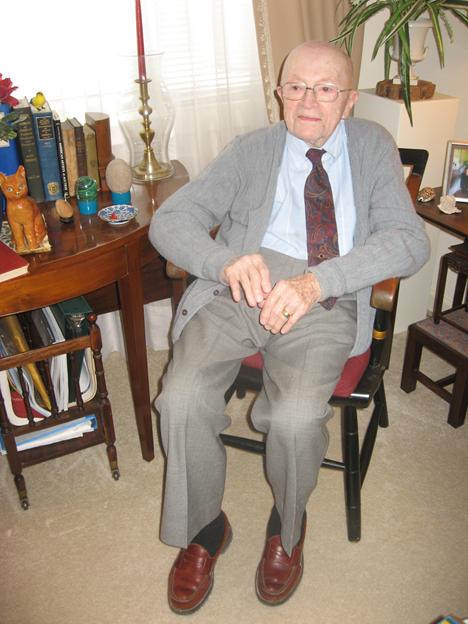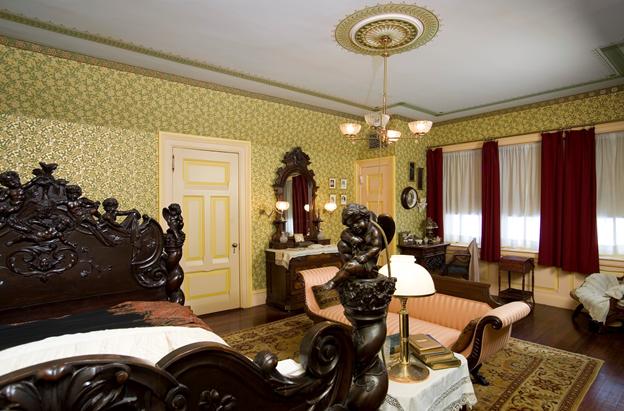The Mark Twain House has gone through many changes since the Clemenses sold their beautiful mansion in 1903. It was purchased by the Bissell family, who updated the house with new elements such as electricity and new flooring. In 1917, the Bissells rented the house to the Kingswood School for boys. In 1922, it was sold to a developer who turned the house into an apartment building. There were 11 apartments in all, with the basement serving as a large dining hall. Each apartment had a fireplace and kitchenette.
In 1929, the house was under threat of demolition. The Friends of Hartford, led by Katherine Seymour Day, purchased the house for the purpose of saving and restoring it. From 1930 to 1956, the Mark Twain Memorial and Library Commission rented out the first floor to the Mark Twain Branch of the Hartford Public Library. The remainder of the house continued to be rented as apartments through the 1960s.
What was it like to live in Mark Twain’s house? We found out last January, when museum consultant Steve Courtney visited Herbert Ristow, age 92, at his home at Seabury, the assisted living facility in Bloomfield, Connecticut. In the 1940s, Herbert lived in the Clemens’s master bedroom suite. He began by telling Steve about the Billiard Room.

Photo of Herbert Ristow, by Steve Courtney
HR: That’s the first room I visited at the Mark Twain House. Back in ‘42 I was working summers at G. Fox – there were a whole group of us working in the advertising and interior display departments – and Polly Elliot lived there. Polly was in the advertising department. She was the daughter of a prominent Hartford physician and quite proper except that dinner was served without any utensils but with napkins and it was a cream sauce – I forget what the meat was – but it was my introduction to Hartford at the Mark Twain House.
SC: No utensils?
HR: No.
SC: So you had to eat with your hands? That was intentional?
HR: Oh yes. She was very artistic. Polly was definitely avant garde. She was married to a young man who was a concert baritone.…At that point he was in the service and she was living at the Mark Twain house.
When I first arrived I had just graduated from high school in Bristol, working as I said at G. Fox in interior display for the summer, and then I went off to Brooklyn to Pratt. When I graduated I was assistant to the head of the decorating department. I visited [the Mark Twain House] almost regularly until I moved there in 1947 and in 1948 I went into the service.
SC: What was it like working for Mrs. Auerbach?
HR: Oh it was a wonderful experience. We used to work a lot at night after the store was closed and she was always around. She was very hands-on. She was a wonderful person and one of my closest friends in that era was her private secretary.
SC: But going back to Polly Elliott. She was in the billiard room.
HR: Yes.
SC: Did that also include the guest room that’s off the billiard room?
HR: No, that was another gal from Fox, Olga Middleton.
Then I visited quite a few times because there were other friends who came and went in the house. And it was interesting the way in which you were allowed to live in the house. You had to go to tea with Katherine Day in the library of the Harriet Beecher Stowe House. Which was an interesting experience in itself, because the library was filled with wonderful books behind locked cages. She was an imposing figure, and you had to be of the proper sort. Your religion had to be right, your politics had to be right. Oh, yes.
SC: What religion and which politics?
HR: White Anglo-Saxon Protestant.
SC: And Republican?
HR: Oh, and Republican, of course. No doubt about that.
SC: Of course, she is praised to the skies because she saved both houses.
HR: Oh yes, and of course a lot of the correspondence came through her brother Pomeroy Day’s law office. The rent was $48 a month.
The other tenants weren’t all from G. Fox – there was a book reviewer from the Hartford Times. She had the apartment that’s now the girls’ bedroom.
In your process of doing this, did you run across Grace Sparhawk? She lived originally in the kitchen ell. And Grace was a widow of a Philadelphia lawyer. Everything had to be purple or lavender. Her clothes, her decoration, everything. And she as a teenager had known Mark Twain. She was a great person to talk with. She told me I was a very adaptable young man, whatever that meant.
SC: I wonder what her name was when she knew Mark Twain – her maiden name.
HR: Now hang on, I should know. Two of her nephews were prominent. Bill Scoville who was a world famous neurosurgeon, who was a friend of mine and a client – Bill was the one who did the lobotomy on Rosemary Kennedy. It’s a small world. And his brother was Gurdon Trumbull Scoville. [A 1993 Courant obituary of Rev. Gurdon Trumbull Scoville says he was a great-grandson of both Henry Ward Beecher and the Rev. Thomas Hopkins Gallaudet.] They had also married into the Cheney family of Manchester.
SC: People have commented on the “connectedness” of Hartford.
HR: Oh that’s one thing I learned when I came to Hartford – watch your mouth, because everybody’s related to everybody else.
After I came back from the service, I had contact with a gal who lived in a studio in the basement of the Mark Twain House with her sister, and they lived in that little area just in front of where that printing machine was. [That is, the area near the exterior door of the basement where the Paige typesetter was displayed before it was moved to the Visitors’ Center in 2003.]
We used to go up the back stairs. Now you can’t do that.
SC: The little stairs that go up to the kitchen?
HR: Right.
SC: You mean when you lived there?
I didn’t live there very long, because it just so happened that I was drafted into the service.
SC: So you entered through the public library.
HR: Yes, I remember the library being there.
SC: The only impression I have of what it was like to live there is a 1947 mystery written by Lee Thayer called Murder Stalks the Circle. It’s about Woodland Circle. But the detective lives in the billiard room on the third floor of the Mark Twain House. We have some copies at the Mark Twain House.
HR: Oh! I’ve been trying to get a copy of her book for years and can’t find it. I’ve had people looking for that for years. Murder Stalks the Circle and Daughter of the House.
[Note: Daughter of the House by Evelyn Perkins Ames is a 1962 memoir of life in Nook Farm in the decades before the author’s family home was demolished along with others for the construction of Hartford High School. Ames’s family donated the music box in the front hall of the Mark Twain House. I was later able to get Mr. Ristow his own copies of these two books, and a copy of the extraordinary unpublished history of the house by Walter Schwinn. Schwinn, he said, was also a friend and decorating client of his.]
SC: The detective in Murder Stalks the Circle is sort of a dapper man like Lord Peter Wimsey, and he has a faithful valet. There’s one scene in which Thayer describes the stairwell: “The door to what had once been a billiard room was open and a cheerful bright light streamed across the hall, but it did little to alleviate the gloom of the great square well of the staircase, though there was one bulb burning on each landing.”
HR: Yes, that’s a good description!
SC: So you had visited various people in the house, but what possessed you to move in?
HR: Well, the last person before me got married – Helen Halverson. She married a chap that I shared a bachelor apartment with. But when I got called into the service, I wrote to Katherine Day, and she wrote back and said they would never rent that area out again. Because I got called into the service, the gal before me got married, and the woman before that died in the bathtub. You know the area just beyond the master bedroom – it’s a dressing room and a bathroom. I understand it’s now all blocked off.
SC: So when you got back you were hoping to return?
HR: I was hoping to, but it didn’t work out that way. I went on and moved to West Hartford and lived there for 46 years, got married and all the rest of it.
SC: How was it set up while you were there?
HR: The dressing room – that was the kitchen.
SC: I get the feeling that these were little kitchenettes.
HR: Right. There was also one in the billiard room, in the corner near the balcony.
SC: Presumably when you were there the famous Tiffany stenciling was all under wallpaper and paint.
HR: Well, you wouldn’t have recognized it, anyway.
As far as how the room was done up, it was done as a bed sitting room, and the walls were painted a cocoa color, and we made curtains of white sheets. The closets weren’t there.
SC: No ghosts?
HR: No ghosts.

We are always looking out for the secrets that the Mark Twain House reveals over time through new research and new technologies. The house has been painstakingly restored to the period between 1881 and 1889. When on a tour, it is nearly impossible to find any trace of the school, apartments, or library that was once sheltered by Samuel Clemens’s beloved home.
—Tracy Brindle, Beatrice Fox Auerbach Chief Curator

